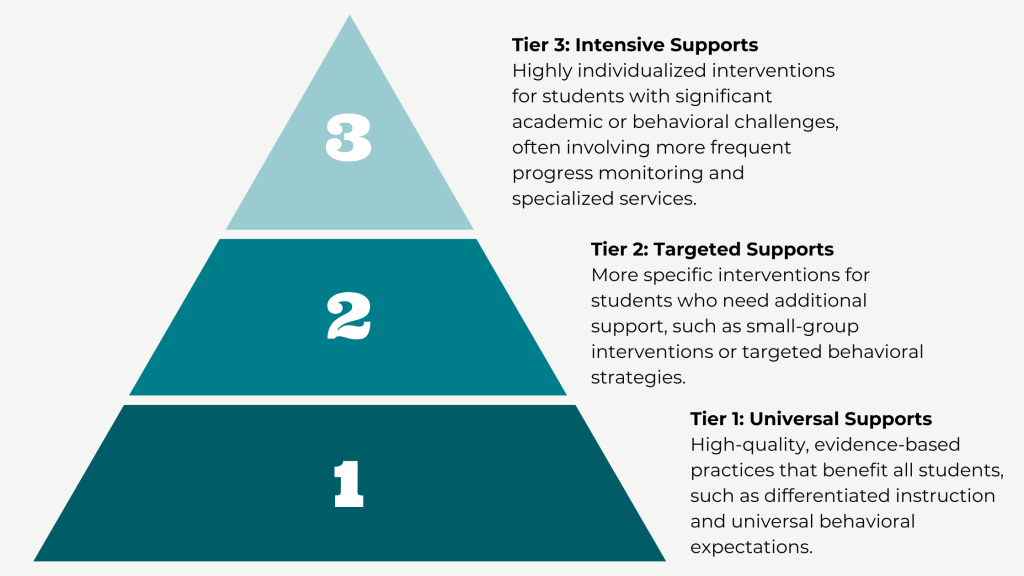As school leaders, one of the most impactful steps you can take to address your teachers’ concerns and impact students’ success is implementing a comprehensive Multi-Tiered System of Supports (MTSS) on your campus. MTSS is a framework that integrates academic, behavioral, and social-emotional supports into a unified system to address the diverse needs of all students.
When effectively implemented, MTSS promotes early identification of student needs, provides targeted interventions, and continuously monitors student progress to ensure every student receives the support they need to thrive. The goal of MTSS is to close gaps in academic and behavioral needs so that students can succeed in the classroom.
This idea of implementing MTSS can feel overwhelming when we think about it as a whole, but like with most journeys, we must take it one phase at a time. You need to determine where your team is in the journey and the next steps you need to take to move the work forward. You may find this Implementation Checklist a helpful tool for doing that. This free, downloadable resource is a campus assessment checklist to help you determine areas of need and a goal-setting framework to map out your journey to successfully supporting students with your MTSS protocol.
What is a Multi-Tiered System of Supports?
Let’s begin with a brief overview of a Multi-Tiered System of Supports (MTSS). MTSS is a proactive, data-driven framework that helps schools provide support to all students. It’s designed to be a flexible system that can address academic and non-academic needs—such as behavioral and social-emotional learning—by offering interventions at varying levels of intensity (tiers). The key components of MTSS include:

MTSS is grounded in continuous data analysis, which monitors progress, makes adjustments as needed, and ensures that interventions meet students’ needs.
Let’s look at three phases for MTSS implementation. Each phase aligns with the FREE Implementation Checklist and provides additional questions and topics to consider with your MTSS team.
Phase 1: MTSS Planning—Preparation, Preparation, Preparation!
As with any journey, the planning phase is critical to the success of MTSS. During this phase, school leaders must ensure a clear understanding of the goals and vision for MTSS, along with the buy-in from all stakeholders.
Guiding Questions for Phase 1: Planning
- What are the goals and vision of the MTSS process on our campus?
- Have we clearly defined the outcomes you want to achieve with MTSS? For example, is the goal to increase academic achievement, reduce behavior referrals, or improve attendance?
- How will MTSS support the overall mission and vision of our school?
- How do we ensure buy-in from all stakeholders (teachers, staff, parents, and community)?
- How can we involve key stakeholders in planning to ensure their support and input?
- How will we communicate the benefits of MTSS to staff, students, and families?
- Have we built a strong MTSS team?
- Do you have a cross-functional team of educators, specialists, counselors, and administrators to help guide the implementation of MTSS?
- How will the team collaborate to ensure that all aspects of MTSS are well-coordinated and aligned?
- What training does our team need to ensure best-practice implementation for targeted instruction and MTSS process management?
- Are intervention strategies clearly defined for each tier (1, 2, and 3)?
- What interventions will be implemented at each tier, and how will they be delivered (e.g., small groups, by whom, content, or curriculum)?
- Do you have a clear system for determining when students move between tiers?
Phase 2: MTSS Implementation—Setting Out on the Trail
Once your MTSS framework is in place, the next phase is implementation. It’s time to lace up your boots and start hiking! This is when your school begins to implement its plan, focusing on setting up systems for screening, monitoring, and ongoing intervention. Effective implementation requires consistent data analysis, regular collaboration, and family communication.
Guiding Questions for Phase 2: Implementation
- How do we screen and monitor students’ data?
- Do we have a clear, consistent process for screening students (e.g., assessments or behavior checklists)?
- How frequently will we review student data to identify those who need additional support?
- How do we monitor student responses to interventions?
- What data will we collect to measure whether interventions work (e.g., academic assessments, behavioral observations)?
- How will we track and analyze the progress of students in each tier?
- How do we ensure continuous data analysis to monitor student growth?
- Are there regular intervals (e.g., monthly or quarterly) when the MTSS team reviews progress and adjusts interventions?
- How will we use student data to make informed decisions about next steps for individual students?
- How are we engaging families and the community in the MTSS process?
- What communication strategies will we use to inform families about their child’s progress and involvement in MTSS?
- How can we encourage parents to play an active role in supporting interventions at home?
- How are we promoting an inclusive and positive school culture?
- How will you ensure that the MTSS process is inclusive of all students, regardless of their background or needs?
- What steps can you take to create a positive school culture where all students feel supported and valued?
Phase 3: Reflect and Refine—Overseeing the MTSS Process and Adjusting as Needed
The final phase in the MTSS process is reflection and refinement. It’s essential to regularly assess the effectiveness of the MTSS system and make necessary adjustments to improve outcomes. This phase involves gathering feedback from all stakeholders, analyzing the results, and ensuring that MTSS practices are continuously evolving.
Guiding Questions for Phase 3: Reflecting and Refining
- How do we periodically review our MTSS practices and outcomes?
- How often will the MTSS team meet to review the effectiveness of interventions and the overall system?
- What indicators or metrics will we use to measure the success of the MTSS process (e.g., student achievement, reduced discipline referrals, improved attendance, effective teaching practices, teacher retention, etc)?
- What feedback do we gather from stakeholders, and how is it used?
- How will you collect feedback from teachers, students, parents, and other stakeholders about the MTSS process?
- How will feedback be incorporated into future planning and improvement?
- What additional training or professional development is needed for staff?
- Based on the feedback and the review of outcomes, are there areas where staff may need further training or support to effectively implement MTSS (e.g., intervention strategies, data analysis)?
- How will we provide ongoing professional development to ensure staff remain up-to-date with best practices?
- How do we document and report progress?
- Do you have a system in place to document the outcomes of interventions and share progress reports with stakeholders?
- How will you celebrate successes and highlight improvements in student outcomes?
Final Thoughts
By focusing on these three phases—Planning, Implementation, and Reflecting and Refining—school leaders can build a strong MTSS system that meets the needs of all students. A successful MTSS framework provides a clear structure for identifying and addressing student needs early on, supporting students at multiple levels, and continuously improving based on data and feedback. With thoughtful planning, consistent implementation, and regular reflection, school leaders can ensure that their MTSS processes lead to meaningful, lasting student improvements.
As you continue your journey, keep the guiding questions as your compass, and remember that MTSS is more like a long trek than a short day hike. It’s not a one-time destination but a path that requires constant navigation and course adjustments. By staying adaptable and committed to making steady progress, you’ll build a system that provides the support every student needs to reach great heights.
Natalie is an Educator Evaluation and Leadership Administrative Specialist at ESC Region 13.






Add comment